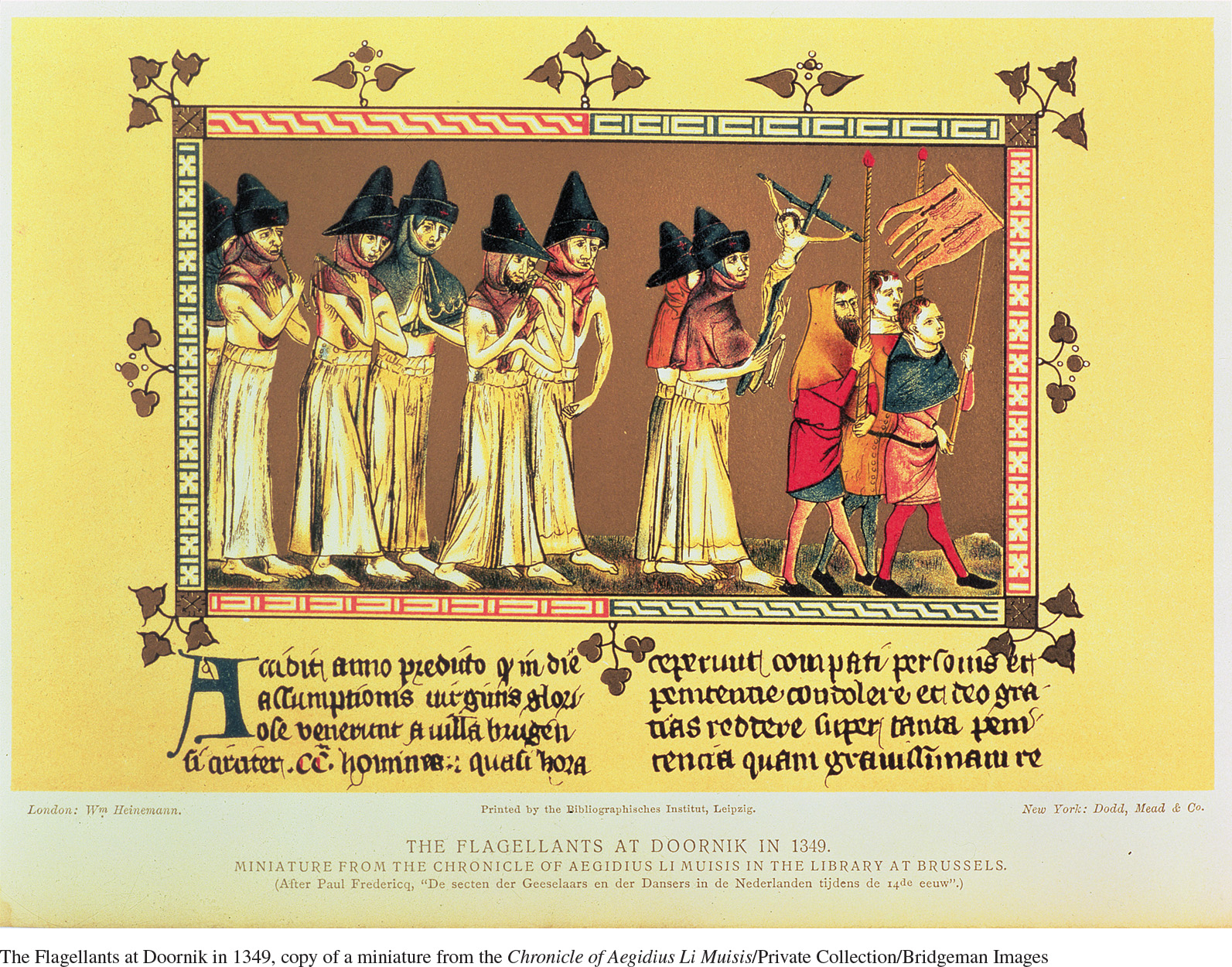Source 11.5: Religious Responses in the Christian World
The horrific experience of the Black Death also caused some people in the Christian world to question fundamental teachings about the mercy and power of God or the usefulness of religious rituals. For some, the plague prompted an orgy of hedonism, perhaps to affirm life in the face of endless death or simply to live to the full in what time remained to them. Most European Christians, however, relied on familiar practices: seeking the aid of parish priests, invoking the intercession of the Virgin Mary, participating in religious processions and pilgrimages, attending mass regularly, increasing attention to private devotion. From church leaders, the faithful heard a message of the plague as God’s punishment for sins. Accompanying such ideas were religiously based attacks on prostitutes, homosexuals, and Jews, people whose allegedly immoral behavior or alien beliefs had invited God’s retribution.
The most well-known movement reflecting an understanding of the plague as God’s judgment on a sinful world was that of the flagellants, whose name derived from the Latin word flagella, meaning “whips.” The practice of flagellation, whipping oneself or allowing oneself to be whipped, had a long tradition within the Christian world and elsewhere as well. Flagellation served as a penance for sin and as a means of identifying with Christ, who was himself whipped prior to his crucifixion. It reemerged as a fairly widespread practice, especially in Germany, between 1348 and 1350 in response to the initial outbreak of the plague. Its adherents believed that perhaps the terrible wrath of God could be averted by performing this extraordinary act of atonement or penance. Groups of flagellants like those depicted in Source 11.5A moved from city to city, where they called for repentance, confessed their sins, sang hymns, and participated in ritual dances, which climaxed in whipping themselves with knotted cords sometimes embedded with iron points.
The initial and subsequent outbreaks of the plague in Western Europe generated an understandable preoccupation with death and its apparently indiscriminate occurrence. This concern, or obsession, found expression in the Dance of Death, a ritual intended to prevent the plague or to cure the afflicted, which began in France in 1348. During the performance, people would periodically fall to the ground, allowing others to trample on them. By 1400, such performances took place in a number of parish churches and subsequently in more secular settings. The Dance of Death also received artistic expression in a variety of poems and sketches along with paintings like Source 11.5B.
Questions to consider as you examine the sources:
- Does the procession in Source 11.5A seem spontaneous or organized? Do church authorities appear to have instigated or approved this procession?
- In Source 11.5B, what can you infer about the status of the living figures?
- Notice that the living figures face outward toward the viewer rather than toward the entreating death figures on either side of them. What might this mean?

The FlagellantsA contemporary representation of the flagellants in the town of Doornik in the Netherlands in 1349.The Flagellants at Doornik in 1349, copy of a miniature from the Chronicle of Aegidius Li Muisis/Private Collection/Bridgeman Images

A Culture of DeathThis image reproduces a portion of a Dance of Death painting, originally created by the German artist Berndt Notke in 1463 and subsequently restored and reproduced many times. In the inscriptions at the bottom of the painting, each living character addresses a skeletal figure, who in turn makes a reply. Here is the exchange between the empress (shown in a red dress and elaborate head gear) and Death.I know, Death means me! I was never terrified so greatly! I thought he was not in his right mind, after all, I am young and also an empress. I thought I had a lot of power; I had not thought of him or that anybody could do something against me. Oh, let me live on, this I implore you!And then Death replies:Empress, highly presumptuous, I think, you have forgotten me. Fall in! It is now time. You thought I should let you off? No way! And were you ever so much, you must participate in this play, and you others, everybody — Hold on! Follow me, Mr. Cardinal!4St. Nicholas’s Church, Art Museum of Estonia, Tallinn, Estonia/Bridgeman Images
- “Lübeck’s Dance of Death,” accessed May 29, 2015, http://www.dodedans.com/Etext2.htm.

